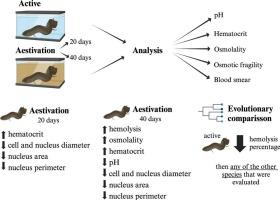Physiological adaptations of red blood cells during aestivation in the south American lungfish Lepidosiren paradoxa
IF 2.1
3区 生物学
Q4 BIOCHEMISTRY & MOLECULAR BIOLOGY
Comparative Biochemistry and Physiology A-Molecular & Integrative Physiology
Pub Date : 2024-10-12
DOI:10.1016/j.cbpa.2024.111765
引用次数: 0
Abstract
The South American lungfish Lepidosiren paradoxa inhabits areas with variable pluvial regimes. During aestivation (dormancy state observed in some species during dry seasons), the prolonged period of dryness imposes osmotic stress. We aimed to investigate the physiological and morphological adaptations of RBCs in Lepidosiren paradoxa during aestivation. Here, the lungfish were subjected to aestivation for 20 and 40 days and compared to a control group in an active period. The osmotic fragility, blood osmolality, and pH were measured. Blood smears were performed to assess morphological changes in the RBCs. Lepidosiren paradoxa presented lower hemolysis when compared with a teleost fish and tegu lizard. Hemolysis increased when the lungfish was subjected to 40 days of aestivation (from 6.04 % to 16.51 %; control vs 40-day aestivation). Hematocrit rose in both aestivation groups compared to the control (26.36 %, 41.36 % and 41 %, control, 20 and 40 days, respectively; p < 0.05) indicating changes in RBC volume and hydration status. Moreover, the results revealed increased osmolality in the 40-day aestivation group (244.4 vs 372.1 mmol/Kg; control vs 40-day aestivation). 40 days of aestivation led to a decrease in blood pH when compared to the control and 20-day aestivation groups. Both aestivation durations resulted in a reduction in the perimeter and cell diameters in at least one direction of the RBCs (24 % mean reduction in size from control to 40 days aestivation). These findings suggest that South American lungfish possess remarkable physiological and morphological adaptations in their RBCs during aestivation.

南美洲肺鱼(Lepidosiren paradoxa)休眠期红细胞的生理适应性
南美洲肺鱼(Lepidosiren paradoxa)栖息在雨量多变的地区。在休眠期(某些物种在干旱季节的休眠状态),长时间的干燥会造成渗透压应激。我们的目的是研究在休眠状态下鲈鱼红细胞的生理和形态适应性。在此,我们对龙鱼进行了 20 天和 40 天的休眠,并与处于活动期的对照组进行了比较。测量了渗透脆性、血液渗透压和 pH 值。进行血液涂片以评估红细胞的形态变化。与远洋鱼类和tegu蜥蜴相比,鳞鱼的溶血率较低。肺鱼休眠 40 天后,溶血率升高(从 6.04% 升至 16.51%;对照组与 40 天休眠组)。与对照组相比,禁食组的血细胞比容都有所上升(对照组、禁食 20 天组和禁食 40 天组的血细胞比容分别为 26.36 %、41.36 % 和 41 %;p <0.05),表明红细胞体积和水合状态发生了变化。此外,结果显示,40 天禁食组的渗透压增加(244.4 vs 372.1 mmol/Kg;对照组 vs 40 天禁食组)。与对照组和禁食 20 天组相比,禁食 40 天导致血液 pH 值下降。这两种休眠期都导致红细胞的周长和细胞直径至少在一个方向上缩小(从对照组到 40 天休眠组的平均缩小率为 24%)。这些发现表明,南美肺鱼的红细胞在休眠期具有显著的生理和形态适应性。
本文章由计算机程序翻译,如有差异,请以英文原文为准。
求助全文
约1分钟内获得全文
求助全文
来源期刊
CiteScore
5.00
自引率
4.30%
发文量
155
审稿时长
3 months
期刊介绍:
Part A: Molecular & Integrative Physiology of Comparative Biochemistry and Physiology. This journal covers molecular, cellular, integrative, and ecological physiology. Topics include bioenergetics, circulation, development, excretion, ion regulation, endocrinology, neurobiology, nutrition, respiration, and thermal biology. Study on regulatory mechanisms at any level of organization such as signal transduction and cellular interaction and control of behavior are also published.

 求助内容:
求助内容: 应助结果提醒方式:
应助结果提醒方式:


